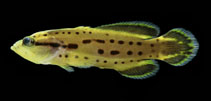http://www.fishbase.org/Summary/speciesSummary.php?genusname=Rypticus&speciesname=subbifrenatus ---> http://192.134.151.83/Summary/speciesSummary.php?genusname=Rypticus&speciesname=subbifrenatus
http://192.134.151.83/Summary/speciesSummary.php?genusname=Rypticus&speciesname=subbifrenatus ---> https://fishbase.mnhn.fr/Summary/speciesSummary.php?genusname=Rypticus&speciesname=subbifrenatus
https://fishbase.mnhn.fr/Summary/speciesSummary.php?genusname=Rypticus&speciesname=subbifrenatus ---> https://fishbase.mnhn.fr/summary/Rypticus-subbifrenatus.html
Rypticus subbifrenatus, Spotted soapfish : fisheries

You can
sponsor
this page
Common name (e.g. trout)
Genus + Species (e.g. Gadus morhua)
-

-
About this page
-
Languages
-
User feedbacks
-
Citation
-
Uploads
-
Related species
-


 Spotted soapfish
Add your observation in
Fish Watcher
Upload your
photos
and
videos
Spotted soapfish
Add your observation in
Fish Watcher
Upload your
photos
and
videos
Pictures
|
Google image
 Rypticus subbifrenatus
Rypticus subbifrenatus
Picture by
Macieira, R.M.
Teleostei (teleosts) >
Perciformes/Serranoidei
(Groupers) >
Grammistidae
(Soapfishes)
Etymology:
Rypticus:
Greek, ryptikos, -e, -on = easy to wash (Ref.
45335
)
.
More on author:
Gill
.
Environment: milieu / climate zone / depth range / distribution range
Ecology
Marine; reef-associated; depth range 1 - 26 m (Ref.
89885
), usually 1 - 2 m (Ref.
89885
). Tropical
Western Atlantic: Eastern Atlantic and Brazilian populations need further investigation, (including morphological and genetic), to determine if they represent
R. subbifrenatus
or undescribed species (Ref.
89885
).
Size / Weight / Age
Maturity: L
m
?
range ? - ? cm
Max length : 18.0 cm TL male/unsexed; (Ref.
7251
)
Dorsal
spines
(total): 3 - 4;
Dorsal
soft rays
(total): 21-25;
Anal
spines
: 1;
Anal
soft rays
: 11 - 13. This species is distinguished from its congeners by the following set of characters: pectoral fin and distal portions of soft dorsal, caudal, and anal fins are tan to brown in life and when preserved; numerous dark spots on head and trunk; spots on head posterior to horizontal through center of orbit usually prominent, round or oblong, and one or more usually equal in size to or larger than diameter of pupil; posterior portion of interorbital region usually with 2 pairs of spots (sometimes joined as a stripe), spots directly on or abutting orbital rim; belly and caudal fin usually without spots; D III or IV (nearly bimodal), total dorsal-fin elements modally 26; pectoral fin rays modally 16; total caudal-fin rays modally 25; lower jaw extending anteriorly beyond upper jaw, mean difference between distance from tip of lower jaw to orbit and tip of upper jaw to orbit 4% HL; caudal peduncle relatively wide, average depth 13% SL (Ref.
89885
).
Inhabits clear tropical waters to depths of 26 m, but it is found most commonly at 1-2 m (mean maximum depth of specimens collected is 5 m, only 6 were captured deeper than 15 m). Lives in tide pools, among coral rubble, in patch reefs and shallow spur and groove reef areas, occasionally found on steep vertical walls (Ref.
89885
). A solitary species (Ref.
26340
). Adults are said to prefer clearer waters than juveniles (Ref.
7320
).
Life cycle and mating behavior
Maturity
|
Reproduction
|
Spawning
|
Eggs
|
Fecundity
|
Larvae
Maugé, L.A.
, 1990. Grammistidae. p. 709-710. In J.C. Quero, J.C. Hureau, C. Karrer, A. Post and L. Saldanha (eds.) Check-list of the fishes of the eastern tropical Atlantic (CLOFETA). JNICT, Lisbon; SEI, Paris; and UNESCO, Paris. Vol. 2. (Ref.
7320
)
IUCN Red List Status (Ref.
130435
)
Least Concern (LC)
; Date assessed:
23 August 2012
CITES
Not Evaluated
Not Evaluated
Threat to humans
Harmless
Human uses
Fisheries: commercial
FAO - Publication:
search
|
FishSource
|
Sea Around Us
More information
Countries
FAO areas
Ecosystems
Occurrences
Introductions
Stocks
Ecology
Diet
Food items
Food consumption
Ration
Common names
Synonyms
Metabolism
Predators
Ecotoxicology
Reproduction
Maturity
Spawning
Spawning aggregation
Fecundity
Eggs
Egg development
Age/Size
Growth
Length-weight
Length-length
Length-frequencies
Morphometrics
Morphology
Larvae
Larval dynamics
Recruitment
Abundance
BRUVS
References
Aquaculture
Aquaculture profile
Strains
Genetics
Electrophoreses
Heritability
Diseases
Processing
Nutrients
Mass conversion
Collaborators
Pictures
Stamps, Coins Misc.
Sounds
Ciguatera
Speed
Swim. type
Gill area
Otoliths
Brains
Vision
Tools
E-book
|
Field guide
|
Identification keys
|
Length-frequency wizard
|
Life-history tool
|
Point map
|
Classification Tree
|
Catch-MSY
|
Special reports
Check for Aquarium maintenance
|
Check for Species Fact Sheets
|
Check for Aquaculture Fact Sheets
Download XML
Summary page
|
Point data
|
Common names
|
Photos
Internet sources
AFORO (otoliths) |
Aquatic Commons
|
BHL
|
Cloffa
|
BOLDSystems
|
Websites from users
|
Check FishWatcher
|
CISTI
|
Catalog of Fishes
:
genus
,
species
|
DiscoverLife
|
ECOTOX
| FAO - Publication:
search
|
Faunafri
| Fishipedia |
Fishtrace
| GenBank:
genome
,
nucleotide
| GloBI |
Google Books
|
Google Scholar
|
Google
| IGFA World Record |
MitoFish
|
Otolith Atlas of Taiwan Fishes
|
Public aquariums
|
PubMed
|
Reef Life Survey
| Socotra Atlas |
Tree of Life
| Wikipedia:
Go
,
Search
| World Records Freshwater Fishing |
Zoological Record
Estimates based on models
Preferred temperature (Ref.
123201
): 25.5 - 28.1, mean 27.4 °C (based on 888 cells).
Phylogenetic diversity index (Ref.
82804
): PD
50
= 0.5010 [Uniqueness, from 0.5 = low to 2.0 = high].
Bayesian length-weight: a=0.01148 (0.00451 - 0.02922), b=3.06 (2.84 - 3.28), in cm total length, based on LWR estimates for this (Sub)family-body shape (Ref.
93245
).
Trophic level (Ref.
69278
): 3.8 ±0.7 se; based on size and trophs of closest relatives
Fishing Vulnerability (Ref.
59153
): Low vulnerability (10 of 100).
Price category (Ref.
80766
):
Very high
.
Nutrients (Ref.
124155
): Calcium = 71.5 [39.3, 138.8] mg/100g; Iron = 0.645 [0.335, 1.129] mg/100g; Protein = 18.6 [16.8, 20.3] %; Omega3 = 0.167 [0.105, 0.265] g/100g; Selenium = 23.3 [13.0, 44.2] μg/100g; VitaminA = 142 [46, 462] μg/100g; Zinc = 1.32 [0.89, 1.93] mg/100g (wet weight);
Back to Search
Random Species
Back to Top
Accessed through:
Not available
FishBase mirror site :
localhost
Page last modified by :
mrius-barile
- 20 July 2016
Fatal error
: Uncaught ArgumentCountError: Too few arguments to function checkEcotox(), 1 passed in /var/www/html/summary/speciessummary.php on line 2304 and exactly 3 expected in /var/www/html/includes/speciessummary.lib.php:2579 Stack trace: #0 /var/www/html/summary/speciessummary.php(2304): checkEcotox() #1 {main} thrown in
/var/www/html/includes/speciessummary.lib.php
on line
2579
|